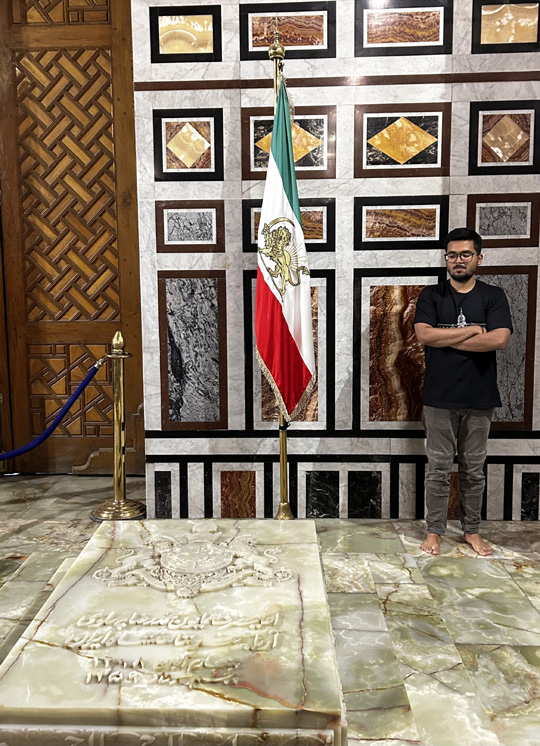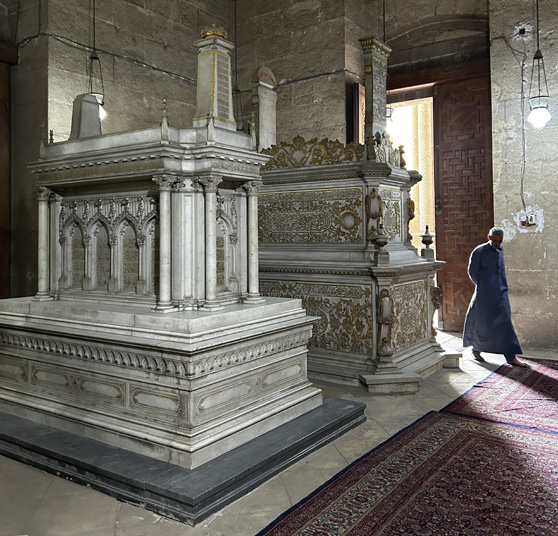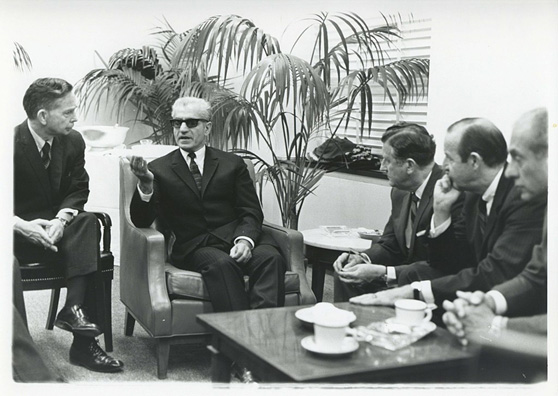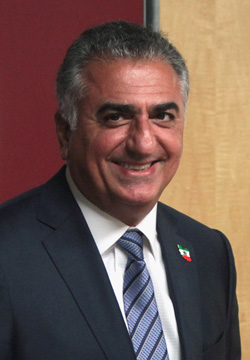
Lead author of this article Mr. Arunansh B. Goswami, standing near the tomb of Shahanshah Aryamehr Mohammad Reza Pahlavi the last Shahanshah of Iran buried in Al-Rifa’i mosque in Cairo. Photo Credits: Mr. D. B. Goswami.
Moving through the streets of Cairo, one notices a profoundly rich history, bearing influences of centuries of migrations and assimilations of diverse ethnicities in this cosmopolitan metropolis. From Abbasids (Sunnis) to Fatimids (Shias), from Bahri Mamluks (Central Asians) to Burji Mamluks (Caucasians), from Ayyubids (Kurds) to Ottomans (Turks), from the French to the British, many nations dominated Cairo for centuries and left their imprints on its architecture, food and more. On the Salah-al-Din Ayubbi square named after the Kurdish warrior turned king, which this author visited in Cairo, are located several monuments including the Mosque and Madrasa of Sultan Hasan and Al-Rifa’i mosque.
Burials in Al-Rifa’i Mosque
A part of the latter mosque is reserved for the members of the family of Muhammad Ali Pasha, which was in power from the early nineteenth century until 1953 when the modern Egyptian republic was born. Apart from the last two rulers of the Muhammad Ali dynasty of Egypt (Kings Fuad I and Farouk) the last Shahanshah of Iran, Mohammad Reza Pahlavi is buried here too, and in the past, his father and founder of the Pahlavi dynasty of Iran Reza Shah was also buried here.

Burials of members of the family of Muhammad Ali Pasha in Al-Rifa’i Mosque, a member of this family Princess Fawzia Fuad, married Shahanshah Mohammad Reza Pahlavi. Princess Fauzia’s family was in power from the early nineteenth century until 1953 when the modern Egyptian republic was born. Photo Credits: Mr. Arunansh B. Goswami.
The Pahlavis have become increasingly important, in global geostrategic conversations, when the Iran-Israel conflict aggravated recently because of the Gaza war. Who were these Shahanshahs of Iran who were considered modernists and friends of the West and why is it they are associated so much with Iranian nationalism? What were their relations with Egypt that led to pan-Arabism and the Non-Alignment Movement under Gamel Abdel Naseer? We will try to explain about the Pahlavis of Iran and their geostrategic importance, in this article.
Pahlavis and Iranian Nationalism
According to M. Reza Ghods in his paper “Nationalism and Reza Shah” published by Taylor & Francis, Ltd. [Source: Middle Eastern Studies, Jan., 1991, Vol. 27, No. 1 (Jan., 1991), pp. 35-45] “By the time of his coronation, Reza Shah had become the receptacle of the nationalists’ hopes.” Ghods writes about Shah Mohammad’s father Reza Khan that his transformation from Cossack colonel to Shah Iran was fostered primarily by Iranian nationalism, which sought a strong centralized government to replace the administrative chaos in the wake the Constitutional revolution and World War I. Though the first Pahlavi monarch certainly exploited political divisions in his rise to power, but liberal and conservative Iranian nationalists were among Reza Khan’s most outspoken early admirers.
Those who have studied the history of Persia must be aware that Persia (Ancient Iran) was the military and geopolitical superpower of the ancient world, its empire extended from Egypt to Punjab and from Central Asia to most of West Asia. Punjab, West of the Indus and Sindh were annexed by Persian emperor Darius and these areas constituted the 20th Satrapy of Iran. This area became the most fertile area of the Persian empire. 360 talents of gold were paid as a tribute to the Persian empire which constituted one-third of their revenue from Asian provinces. The Pahlavis admired the history of ancient Iran (Persia) and Zoroastrian emperors like Cyrus and Darius.
Zoroastrianism and Israelites
Pahlavis have admired the ancient faith of Iran Zoroastrianism, even though they are Shia Muslims. The reason has been explained before, Zoroastrianism and Ancient Persia for them were related to Iranian national identity. Monica M. Ringer from Amherst College writes in her paper “Iranian Nationalism and Zoroastrian Identity: Between Cyrus and Zoroaster” that “The lines between Zoroastrian and Iranian identity were naturally indistinct. Reza Shah’s interest in Zoroastrianism even led one American diplomat to speculate that the Shah might one day establish it as the state religion. …Not surprisingly, Zoroastrians frequently laid claim to preeminence as the most Iranian of Iranians. A writer in the journal Pendarha exclaimed that “the [Zoroastrian] youth have not forgotten old ways and ancient customs. You are the souvenir of an illustrious past. Long live the king.”
Shahanshah Mohammad Reza Pahlavi took the title of Aryamehr meaning the light of the Aryans. In the year 1971, Iran celebrated the 2,500th anniversary of the founding of the monarchy by Cyrus, under his leadership, he organised the most expensive party ever thrown in the world for this. Aryamehr had immense respect for Cyrus who is known in world history as liberator of the Jews, he set the Jews free from their Babylonian Captivity that had taken place decades before. Cyrus facilitated their return to the promised land and he became a notable figure in the Jewish scripture as a savior who helped them build the Second Temple in Jerusalem.
Ayatollahs’ Iran
According to research paper “Khomeini: “We Shall Confront the World with Our Ideology”,” Middle East Report 88 (June 1980)” for Khomeini, Iran should not just be an Islamic republic but a clerical republic…..there is a fundamental contradiction between Khomeini’s interpretation of Islam and secular notions of democracy.” Ayatollah Khomeinei said in his speech “We are fighting against international communism to the same degree that we are fighting against the Western world — devourers led by America, Israel and Zionism.
My dear friends, you should know that the danger from the communist powers is not less than America and the danger of America is such that if we show the slightest negligence we shall be destroyed. Both superpowers have risen for the obliteration of the oppressed nations and we should support the oppressed people of the world (Source: Radio Tehran, March 21, 1980).” In the past, Russia and the U.K. had pushed Reza Shah into exile, and later the Iranian Revolution, also known as the Islamic Revolution, overthrew Shahanshah Aryamehr, and he had to leave Iran for Egypt. Shahanshah Aryamahr is still buried in Cairo, and his son Reza Pahlavi still lives outside Iran, primarily in the West.
Aryamehr’s Son
Sonja Gillert, Christine Kensche and Nahal Toodi write in their introduction, to their interview of prince Reza Pahlavi for Politico and the German newspaper WELT that “Reza Pahlavi, the son of the last shah of Iran, has often been seen as a solo actor determined to bring about the end of the Islamist forces that took over his native country more than 40 years ago.” In the past, Cyrus the Great freed the Jews from Babylonian captivity and sent them to Jerusalem, and a follower of Cyrus, prince Reza Pahlavi, prayed for peace between Israel and Iran on a visit to the Western Wall in Jerusalem, Israel. Tensions between Israel and Iran have increased substantially over the past few months. What will be the result of this, only God knows, but if Prince Reza Pahlavi returns as Shahanshah of Iran or a constitutional monarch of a democratic Iran, it may result in a tectonic shift in Iran’s foreign policy, leading to the normalisation of Iran’s ties with Israel and possibly Arab states as well.
However, the return of the Pahlavi dynasty to power in Iran appears extremely difficult in the current geopolitical circumstances, but a possibility of the same if the US decides to more strongly interfere in the politics of West Asia cannot he gainsaid. Iran, whatever may be the case, will continue power struggle with other major powers, because the superpower of the ancient world will not allow its competitors to succeed in becoming stronger than itself.
(Mr. Arunansh B. Goswami, has written this article along with Mr. Sumit Kaushik a Ph.D. candidate in O.P. Jindal Global University, Sonipat).






